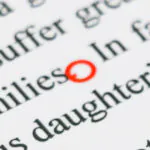
Proofreading Tips: A Quick Guide to Canadian English
Canadian English combines aspects of both American and British English, as well as having its own purely Canadian terminology and usage. We’ve put together a quick guide to Canadian English for proofreaders to highlight general guidelines for working with this dialect.
Canadian English Spelling
Canadian English usually follows British spelling conventions. For instance:
Canadian English: theatre, centre, colour, defence
American English: theater, center, color, defense
It also uses the same noun–verb spelling distinction for words like “practice” and “practise” or “licence” and “license” as British English, which does not exist in American English. And most Canadians follow the rule about doubling the “l” in words like “travelling.”
However, Canadian English follows US conventions in a few cases:
- With -ize/-yze endings instead of -ise/-yse (e.g., organize, realize, analyze).
- Using -e- instead of -ae- in words like “encyclopedia.”
- Words where Canada has strong connections to the US, such as most automotive terms (e.g., curb vs. kerb, tire vs. tyre) and the word “aluminum” (not “aluminium”).
In addition, there is variation across Canada. American English exerts more influence in some places than others, meaning American spellings are more likely to be adopted.
This variation can be confusing, so it’s important to follow your client’s style guide on spelling preferences. But if you’re in doubt about a specific word, you can always look it up online.
Vocabulary
As with spelling, Canadian vocabulary includes a mix of British and American terms, though it leans toward American English. This is especially true in areas where there is a lot of exchange between the US and Canada, such as the previously mentioned automotive industry (e.g., Canadians are more likely to say “hood” than “bonnet” or “highway” than “motorway.”
There are also lots of words where either the British or American term will be accepted. “Holiday” and “vacation” are both commonly used and understood, for example.
And there are many terms unique to Canada, often called Canadianisms. Many of these are less formal, but they include plenty of everyday words (e.g., a “toque” is a woolen hat).
Due to this mix of American, British, and Canadian terms, it can be difficult to know which is correct when proofreading. But as long as you follow your style sheet and look up any unfamiliar Canadianisms you encounter, you should be able to ensure clarity.
Canadian English Punctuation
Canadian English follows American punctuation practices in most respects: e.g., using double quote marks as standard, or adding a full stop to abbreviations like Mr. and Mrs.
There are exceptions: Canadians only typically use a serial comma for clarity, not in every list of three or more items. And Canadians are happy to use either spaced en dashes – like this – or unspaced em dashes—like this—for parentheticals, whereas em dashes are far more common in US English. And while neither of these are likely to pose major issues, it is worth being aware of these conventions when editing a document in Canadian English.
As a rule, though, you should follow US punctuation rules when proofreading Canadian English, as well as checking that everything is clear and consistent.
Tips and Resources for Proofreaders
Proofreaders who are not native Canadians can still proofread in the Canadian dialect. But to make sure you get it right, keep the following in mind:
- Follow your client’s brief and style sheet where available, including all guidelines on spelling, vocabulary, and punctuation. If they do not provide this information, make sure to ask them if they have a preferred style guide before you start working.
- Set your word processor to use Canadian English for the spellchecker.
- Check a quality Canadian English dictionary or style guide. You can purchase a style guide, like this one, but there are also free ones available online.
- Make sure to check any unfamiliar spelling or vocabulary online.
And, as always, clarity and consistency within a document are vital.
Becoming A Proofreader
Our Becoming A Proofreader course covers a variety of topics that are pivotal to quality proofreading in any dialect. Check out our free trial and start learning today.








Leave a Comment
Your email address will not be published.